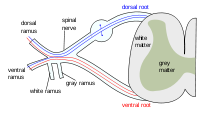
Photo from wikipedia
Background and Objectives: Subcortical grey matter structures play essential roles in cognitive, affective, social, and motoric functions in humans. Their volume changes with age, and decreased volumes have been linked… Click to show full abstract
Background and Objectives: Subcortical grey matter structures play essential roles in cognitive, affective, social, and motoric functions in humans. Their volume changes with age, and decreased volumes have been linked with many neuropsychiatric disorders. The aim of our study was to examine the heritability of six subcortical brain volumes (the amygdala, caudate nucleus, pallidum, putamen, thalamus, and nucleus accumbens) and four general brain volumes (the total intra-cranial volume and the grey matter, white matter, and cerebrospinal fluid (CSF) volume) in twins. Materials and Methods: A total of 118 healthy adult twins from the Hungarian Twin Registry (86 monozygotic and 32 dizygotic; median age 50 ± 27 years) underwent brain magnetic resonance imaging. Two automated volumetry pipelines, Computational Anatomy Toolbox 12 (CAT12) and volBrain, were used to calculate the subcortical and general brain volumes from three-dimensional T1-weighted images. Age- and sex-adjusted monozygotic and dizygotic intra-pair correlations were calculated, and the univariate ACE model was applied. Pearson’s correlation test was used to compare the results obtained by the two pipelines. Results: The age- and sex-adjusted heritability estimates, using CAT12 for the amygdala, caudate nucleus, pallidum, putamen, and nucleus accumbens, were between 0.75 and 0.95. The thalamus volume was more strongly influenced by common environmental factors (C = 0.45−0.73). The heritability estimates, using volBrain, were between 0.69 and 0.92 for the nucleus accumbens, pallidum, putamen, right amygdala, and caudate nucleus. The left amygdala and thalamus were more strongly influenced by common environmental factors (C = 0.72−0.85). A strong correlation between CAT12 and volBrain (r = 0.74−0.94) was obtained for all volumes. Conclusions: The majority of examined subcortical volumes appeared to be strongly heritable. The thalamus was more strongly influenced by common environmental factors when investigated with both segmentation methods. Our results underline the importance of identifying the relevant genes responsible for variations in the subcortical structure volume and associated diseases.
Journal Title: Medicina
Year Published: 2022
Link to full text (if available)
Share on Social Media: Sign Up to like & get
recommendations!